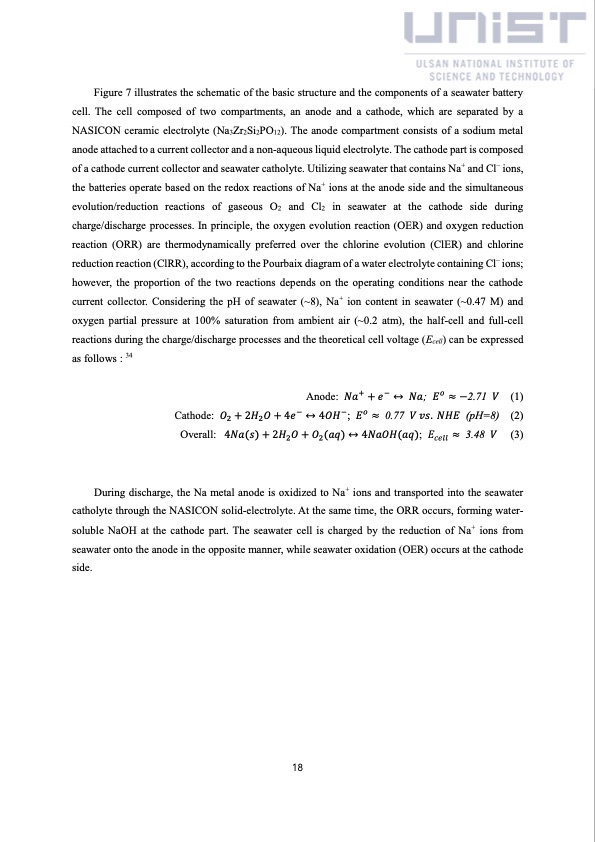
PDF Publication Title:
Text from PDF Page: 023
Figure 7 illustrates the schematic of the basic structure and the components of a seawater battery cell. The cell composed of two compartments, an anode and a cathode, which are separated by a NASICON ceramic electrolyte (Na3Zr2Si2PO12). The anode compartment consists of a sodium metal anode attached to a current collector and a non-aqueous liquid electrolyte. The cathode part is composed of a cathode current collector and seawater catholyte. Utilizing seawater that contains Na+ and Cl– ions, the batteries operate based on the redox reactions of Na+ ions at the anode side and the simultaneous evolution/reduction reactions of gaseous O2 and Cl2 in seawater at the cathode side during charge/discharge processes. In principle, the oxygen evolution reaction (OER) and oxygen reduction reaction (ORR) are thermodynamically preferred over the chlorine evolution (ClER) and chlorine reduction reaction (ClRR), according to the Pourbaix diagram of a water electrolyte containing Cl– ions; however, the proportion of the two reactions depends on the operating conditions near the cathode current collector. Considering the pH of seawater (~8), Na+ ion content in seawater (~0.47 M) and oxygen partial pressure at 100% saturation from ambient air (~0.2 atm), the half-cell and full-cell reactions during the charge/discharge processes and the theoretical cell voltage (Ecell) can be expressed as follows : 34 Anode: 𝑁𝑎+ +𝑒− ↔ 𝑁𝑎; 𝐸𝑜 ≈−2.71 𝑉 (1) Cathode: 𝑂2 + 2𝐻2𝑂 + 4𝑒− ↔ 4𝑂𝐻−; 𝐸𝑜 ≈ 0.77 𝑉 𝑣𝑠. 𝑁𝐻𝐸 (pH=8) (2) Overall: 4𝑁𝑎(𝑠) + 2𝐻2𝑂 + 𝑂2(𝑎𝑞) ↔ 4𝑁𝑎𝑂𝐻(𝑎𝑞); 𝐸𝑐𝑒𝑙𝑙 ≈ 3.48 𝑉 (3) During discharge, the Na metal anode is oxidized to Na+ ions and transported into the seawater catholyte through the NASICON solid-electrolyte. At the same time, the ORR occurs, forming water- soluble NaOH at the cathode part. The seawater cell is charged by the reduction of Na+ ions from seawater onto the anode in the opposite manner, while seawater oxidation (OER) occurs at the cathode side. 18PDF Image | China solar seawater battery

PDF Search Title:
China solar seawater batteryOriginal File Name Searched:
solar-seawater.pdfDIY PDF Search: Google It | Yahoo | Bing
Product and Development Focus for Salgenx
Redox Flow Battery Technology: With the advent of the new USA tax credits for producing and selling batteries ($35/kW) we are focussing on a simple flow battery using shipping containers as the modular electrolyte storage units with tax credits up to $140,000 per system. Our main focus is on the salt battery. This battery can be used for both thermal and electrical storage applications. We call it the Cogeneration Battery or Cogen Battery. One project is converting salt (brine) based water conditioners to simultaneously produce power. In addition, there are many opportunities to extract Lithium from brine (salt lakes, groundwater, and producer water).Salt water or brine are huge sources for lithium. Most of the worlds lithium is acquired from a brine source. It's even in seawater in a low concentration. Brine is also a byproduct of huge powerplants, which can now use that as an electrolyte and a huge flow battery (which allows storage at the source).We welcome any business and equipment inquiries, as well as licensing our flow battery manufacturing.| CONTACT TEL: 608-238-6001 Email: greg@salgenx.com | RSS | AMP |